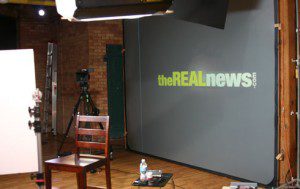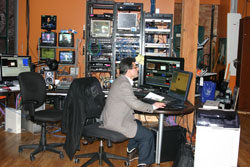Please Do Not Adjust Your Set…
The Real News Network is up and running online, but as for its proposed television programming, well, we're going to have to wait till summer comes along...

Photo by: Court Sloan
The large loft space at 720 Bathurst Street in downtown Toronto easily swallows the equipment and facilities for The Real News Network’s (TRNN) more than two-and-a-half dozen employees. A three-camera studio set-up is tucked away in a far corner opposite the newsroom. The black shades are drawn to eliminate the sun’s glare on the handful of computer screens. Creaks emanate from the ceiling, the result of footsteps one floor above, and seem louder than they really are. That’s because network staff are quietly perched in front of computer screens, headsets over their ears in most cases. They’re reviewing footage fromwire services, capturing clips sent from a reporter in Washington, D.C. and gathering research for their latest stories on the U.S. election primaries. Ultimately, TRNN hopes to post these and other stories and then retu rn to them again and again, offering debate about the issue at hand and comparisons of how other news outlets have covered the same story.
Early last year, when the Review’s Shereen Dindar covered Independent World Television (IWT) readying its news network for launch (“Heard the Independent News?”), CEO and senior editor Paul Jay spoke of providing audiences with in-depth, contextualized stories that would transcend most television news. One year later, the non-profit network runs news programming online as promised, but its television programming remains in the start-up phase.
IWT renamed its video journalism project The Real News Network in 2006, promising to deliver to the world important stories unfettered by commercial interests—no corporate funding, no government subsidies and no advertisements. TRNN called itself the “world’s first truly independent, non-profit, viewer-supported daily video news and documentary service,” transparently divulging sources to its audience as well as its assumptions about a story.TRNN also wanted to avoid pretending its reporters were unbiased. “To be human is to have bias,” states the “What’s real about the Real News?” segment at therealnews.com. Transparency, they hoped, would ensure objectivity in spite of acknowledged biases.
TRNN’s first foray into broadcasting was to offer a 24/7 daily news website, followed later by the launch of an hour-long daily television news show. Deals for the latter are in place with Link TV, Regional News Network and MHZ in the U.S., and Vision TV in Canada, all of which agreed to air the show once it became available. The network began producing online content in August 2007 with the aim to post regularly updated daily news on a 24-7 website. From June to December 2007, the website has posted over 65 video pieces in the site’s top three focus categories in December: Pakistan, Iran and U.S. politics. Meanwhile, the television launch is now scheduled for this summer.
TRNN’s five-year business plan for the period 2007–2012, (which is unreleased and subject to change), states that it requires $8 million by the end of 2008 to achieve its long-term programming goals. The plan also calls for $5,950,000 to launch various TRNN programs and projects, with $3,548,000 allocated for this year’s news and programming. Independent World Television Inc., the charitable foundation that supports the work of TRNN, hopes to raise $6 millionin donations over the course of the year. As with any company, Jay says, if TRNN doesn’t achieve this revenue target, the projections for programming operating expenses will have to be adjusted.
Financial constraints have also somewhat affected the network’s ability to hire experienced personnel capable of producing the level of content TRNN hopes to provide. Jay says it’s difficult to find experienced people willing to stray away from the conventional newsroom. Not being able to offer job security might be part of it, but he says building a team with experience and skills is a challenge.
Allen Booth, TRNN’s web developer, points out that this difficulty is not unique to his company. He says many organizations have an issue with some staff lacking the necessary skills to produce top-notch work. “There’s a bunch of people who can get their work to a certain level with their half-skills,” he says, “and then they can’t take it to the next level.” There are people who can tweak work and bring it to a professional standard, he says, but there are just not enough of them.
In addition to a shortage of talent, the delay in television programming has caused frustration with some staff. A number of former employees say they left because they were discouraged by the lack of overall progress. Communications and volunteer coordinator Geraldine Cahill acknowledges the tension, but says they didn’t want to go ahead and produce news content for a few months and then run out of money, so they decided it would be prudent to wait. “It was frustrating for the supporters,” she says, “and it was frustrating for the staff.”

Morteza Abdolalian, a volunteer at The Real News, researches Iranian blog sites
(Photo by: Ana Maria De La Fuente)
Another issue facing TRNN that also depends on money is the fact that Jay’s time is sometimes stretched thin performing the top two roles in the company, CEO and newsroom boss. As the latter, he approves all stories before they go live, but as CEO he has to travel to meet supporters and deal with business concerns. Jeff Boulton, a consultant who observes company processes and then provides advice on increasing efficiencies, and who worked at TRNN very briefly as a finishing editor, says when he was there, work would sometimes sit in a bottleneck awaiting the senior editor’s ultimate approval. “You can’t operate a news organization that way,” Boulton says. “Shit or get off the pot.”
Jay’s response is that this isn’t an issue at all. He says there is no conflict of interest in acting as both CEO and senior editor. Media history, he points out, is full of examples of the principle in a start-up wearing many hats. “How do we avoid it at this stage?” he asks, before arguing that in fact the two sides are very much connected. “This isn’t some institution—the only reason people have given money is because they trust me,” he says. “What we do in terms of news, what gets produced, is entirely about people trusting me and my judgement.”
Having said that, Jay does add that he’d like to be able to hire someone on the business side at some point. “My time is too split,” he admits. But without the additional funds it’ll just have to wait. What really worries him now, he says, is that the organization is so young and vulnerable that any slip-up might make it impossible to sustain TRNN’s reputation.
Despite the slow process, TRNN continues to aim high and intends to follow through on its promise to offer the uncompromising journalism that Jay, his staff and even many former employees so ardently believe in. “The mission is to produce uncompromising journalism that is fact-based, verifiable, in-depth,” Cahill says. “That mission is central and if that gets lost then we might as well shut down.”
When TRNN began, Jay says the mantra was “Go big or go home.” The network definitely still has big ambitions—bigger than its current budget allows for—and nobody’s ready to go home. “The effect I hope we’ll have on journalism is that we’ll create a forum through video storytelling that we can bring to a mass audience,” he says. “If we do that then we can really shake things up—more than just journalism.”
Ashley Pergolas was the Head of Research for the Spring 2008 issue of the Ryerson Review of Journalism.









































